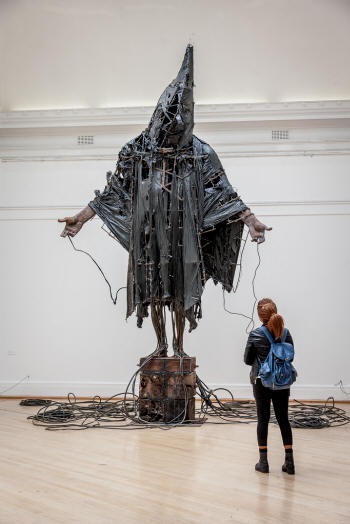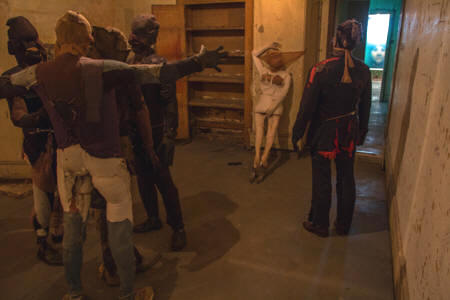|
|
| home | features | exhibitions | interviews | profiles | webprojects | archive |
|
A Twilight Zone of the Human Psyche Mark Hudson considers the sculpture of Tim Shaw, and examines its influences.
Tim Shaw has been described as belonging to a tradition of Modern British Sculpture exemplified by Epstein and Moore, and he has been related particularly to the so-called Geometry of Fear Sculptors (Lynn Chadwick, Kenneth Armitage and Reg Butler), perhaps because of a tendency towards a certain romantic, implicitly political narrativity that sits awkwardly beside the prevailing formalism of twentieth- and twenty-first century art. Yet where Chadwick and Co.’s spiky, haggard, zoomorphic forms relate to very British landscape and nature traditions (manifest in Ted Hughes’s poetry as much as Moore’s sculpture), Shaw identifies with European modernist sculptural traditions in which a classically derived concentration on the human figure predominates.
Intended to embody what Shaw calls a ‘twilight zone of the human psyche’ – between past and present, light and darkness – the cast concrete work extends from the façade towards the viewer in a kind of eyelevel tabletop, beneath which stalactite-like projections bring to mind Gaudí’s Sagrada Familia. The upper surface functions as a kind of piazza in front of the façade, peopled with tiny bronze figures invoking figures from Egyptian and Norse mythology, and from Shaw’s own past and imagination. The sun and moon refer back to his childhood in Belfast, where his father, a linen merchant, took him to the masonic lodge, where such imagery was pervasive. The work by Rodin that first caught Shaw’s imagination and which remains a powerful reference is The Burghers of Calais, the French sculptor’s great narrative magnum opus, which in many ways represents what is least fashionable about Rodin today. When Shaw was making his monumental sculpture The Drummer for Truro city centre, he went to look at The Burghers for the first time in many years, and was surprised by the looseness and rawness of the treatment: ‘I had thought it was formally a lot tighter than it actually is; the handling of the clay is quite Baconesque, a twisting in the way that it’s pushed.’ That’s the aspect of Rodin that speaks to us today – the formal innovator. But there’s another aspect which is less fashionable, but equally meaningful for Shaw: the symbolist and theatrical storyteller who cast real people in the roles of fourteenth-century townsmen, putting them into expressive postures and, in some cases, greatly enlarging their hands and feet in the interests of emotional impact. While Shaw balks at the notion of theatricality in relation to his work, feeling it may diminish his work as sculpture, his mis en scènes follow Rodin’s dramatic example in ways that are direct, yet sometimes surprising. The Burghers of Calais is, in one respect, a precursor of installation art in that it was intended to be shown, unprecedentedly, at ground level, so that viewers would engage with the work in a new way: ‘almost bumping into’ the figures, as Rodin put it, as they went about their daily affairs. The matter of how the figures should be arranged was a matter of considerable doubt for Rodin, and in the version at Stanford University the figures are positioned some distance from each other so that the viewer can walk among them in a way that directly parallels the way the viewer engages with Shaw’s installation Soul Snatcher Possession.
A contemporary British sculptor who did provide that was the maverick monumentalist Michael Sandle, whose A Twentieth-Century Memorial – a large, floor-based work in polished bronze featuring a skeletal mouse firing a life-sized machine gun – expressed a highly personal, avowedly awkward vision, with which Shaw immediately identified. If the work’s allusion to Mickey Mouse aligned it to Pop Art, the work – originally inspired by the Vietnam War – eschewed Pop’s flip, apolitical cool in favour of a more full-frontal, yet brutally comic, engagement with the forces it lampooned. While Sandle was rooted, like Shaw, in heavy metal bronze casting, the French artists Christian Boltanski and Annette Messager opened Shaw’s mind to softer and more transient materials. Boltanski’s Resource (1989), which used worn clothing in a memorial to the concentration camps, drew Shaw’s attention to the way clothing denotes the absence of the person who wore it and ‘the time they existed in’, while Messager’s inflating and deflating installations featuring parachute material emphasised the way materials change their form in varying atmospheric conditions. Fugitive effects of materials seen in the surrounding landscape became suggestive for Shaw: an old jumper caught on a tree, seen from the corner of the eye at dusk, could become quite intimidating. ‘The mind fills in the rest of the form,’ says Shaw, ‘and that is not a pleasant experience.’ Black baling plastic, a feature of the surrounding agricultural landscape, caught in tatters on barbed wire, became a material to be worked with, notably in the streaming mass of the Man on Fire, and in the dully gleaming raiment of the figure in Casting a Dark Democracy.
Shaw’s sensibility and personality were described recently by a friend as ‘pre-modern’, a notion that intrigued him. He is the same age as the so-called YBA artists. He feels no antipathy towards them; indeed he might be said to have something in common with Damien Hirst in his pursuit of big, primal themes. But, unlike theirs, his work is not framed – implicitly or explicitly – by the marketing process; it isn’t amused by itself. It doesn’t seek legitimacy from academic coteries or theoretical schools. As Robert Hughes wrote of Anselm Kiefer, Shaw’s work ‘sets itself against the sterile irony and sense of trivial pursuit that infect our culture’. Following his intuition as he strives beyond the social and political to things that are, as he says, ‘deeper and more universal’, Shaw is a free agent.
Tim Shaw's new monograph is published by Sansom and co:
|
|
|


